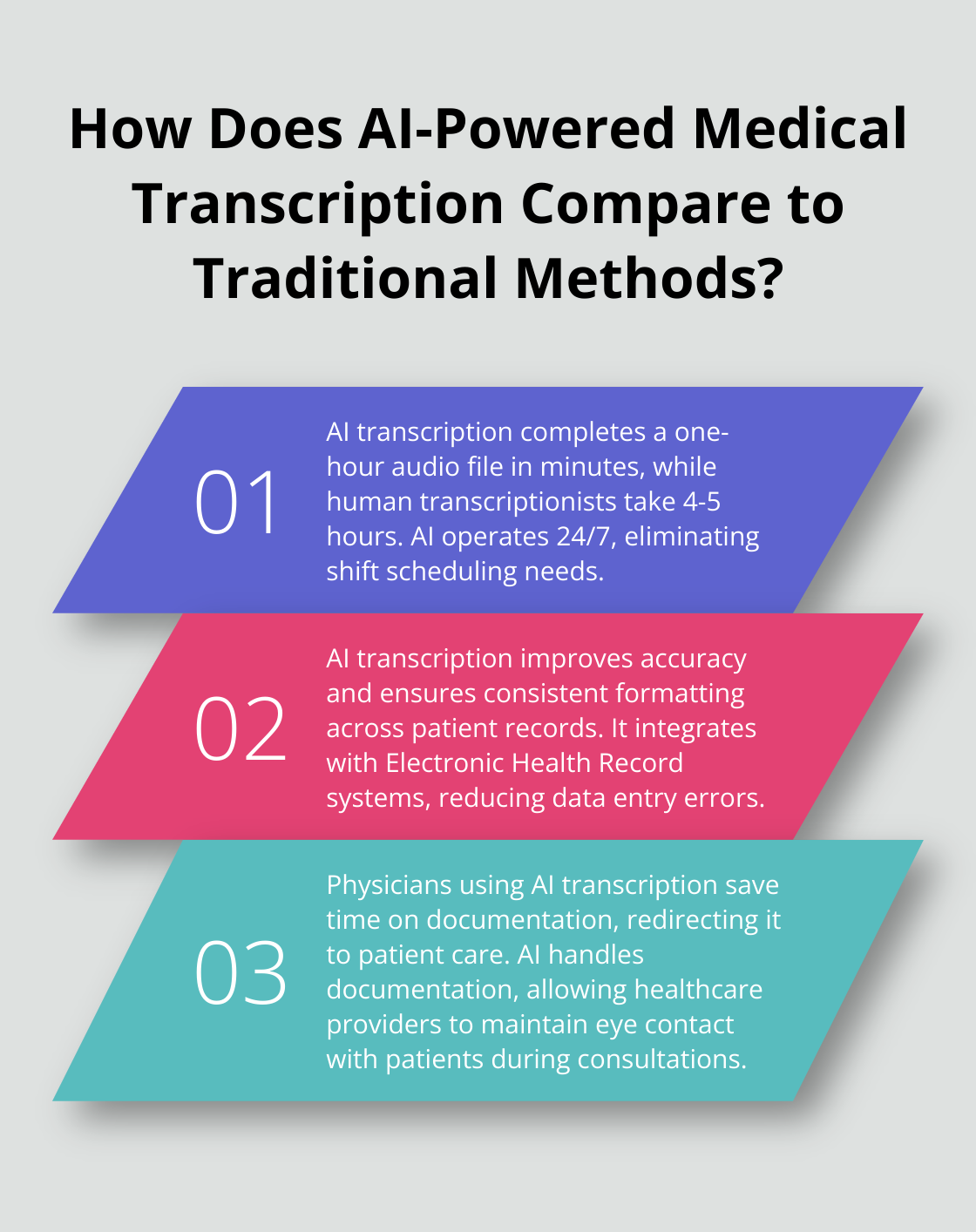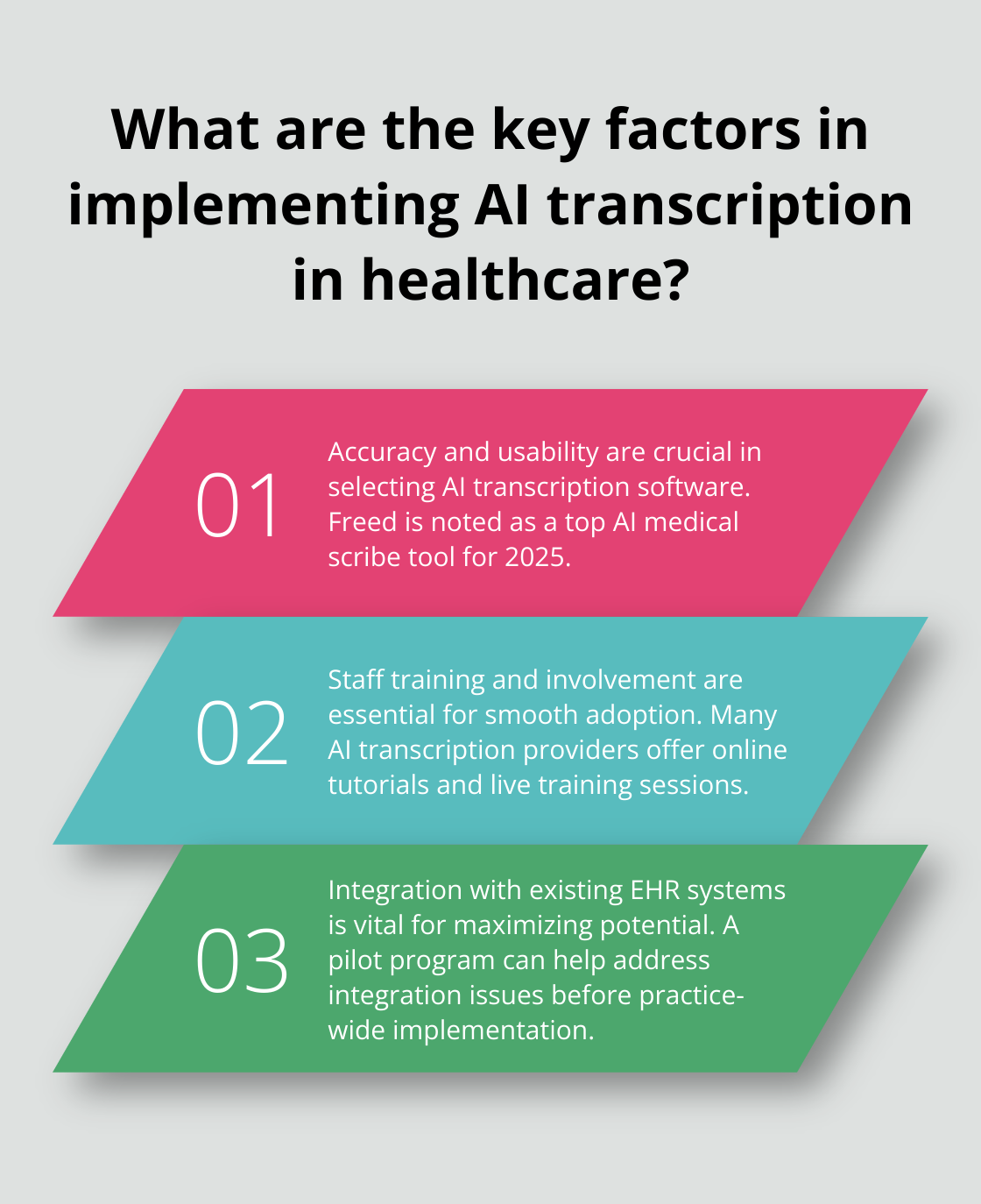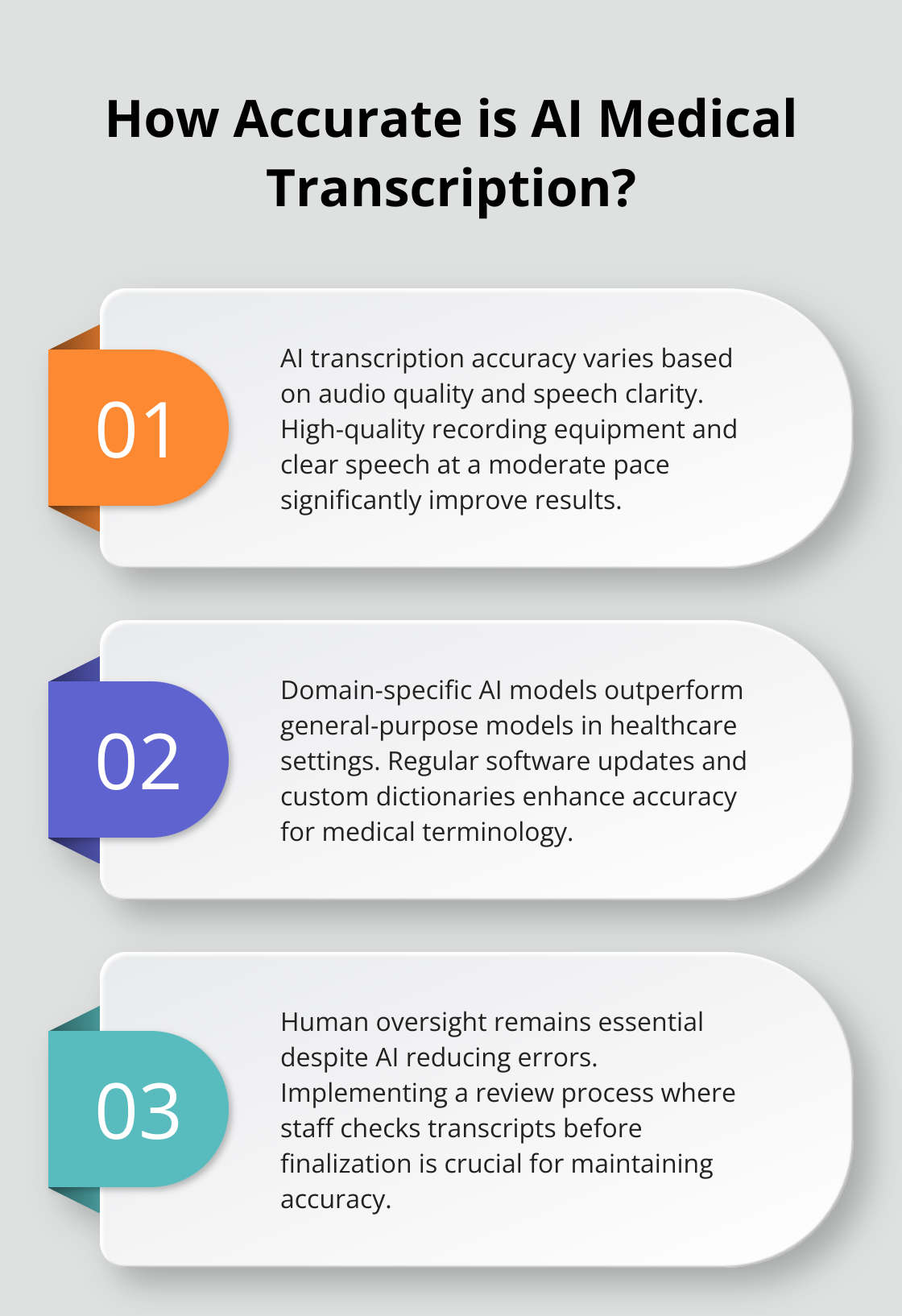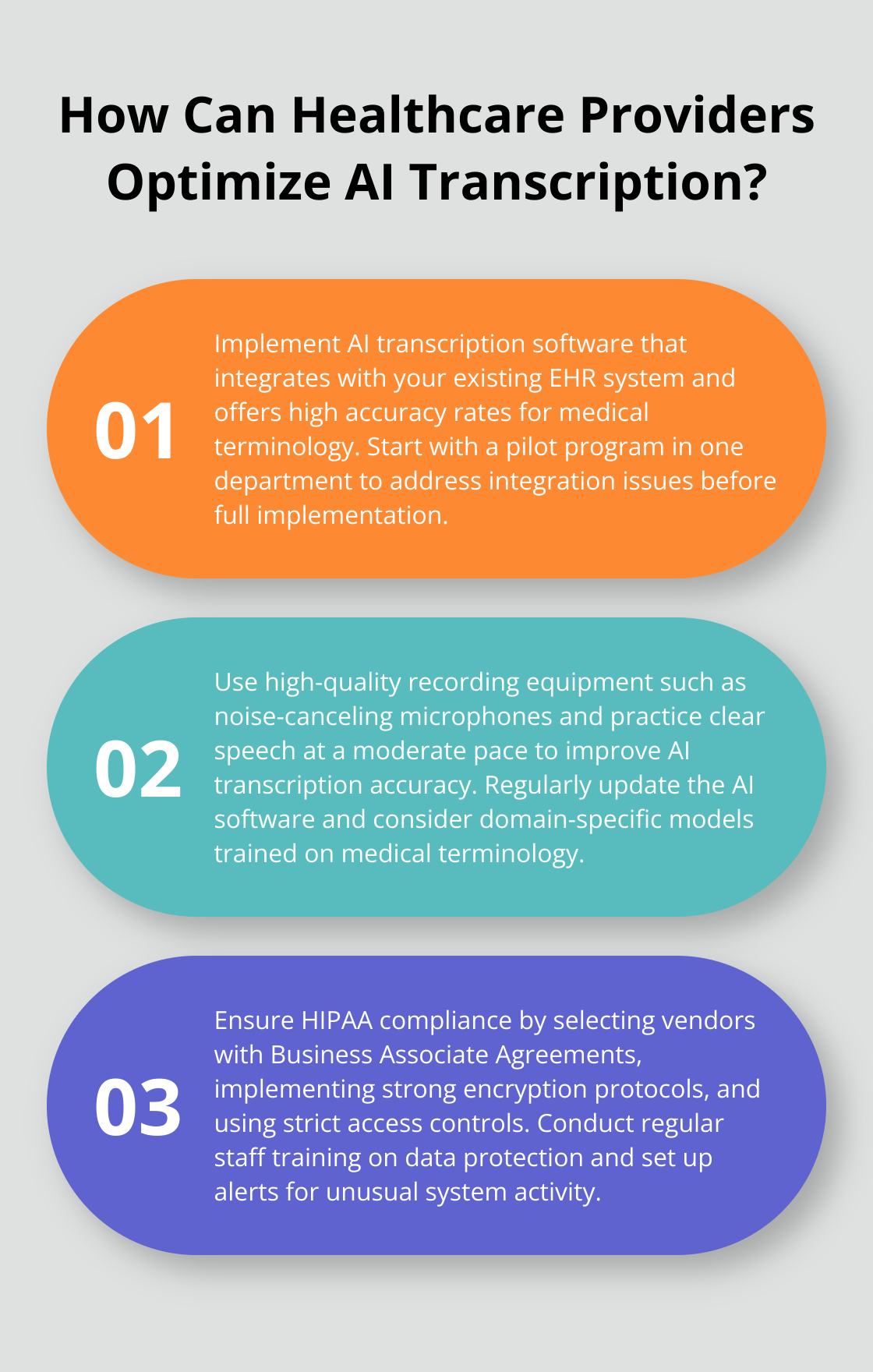Artificial intelligence is revolutionizing medical transcription, transforming how healthcare professionals document patient information. At ScriberJoy, we’ve seen firsthand how AI-powered tools boost efficiency and accuracy in medical records.
This blog post explores the implementation of AI in medical transcription, its benefits, and how to overcome common challenges. We’ll guide you through the process of adopting this game-changing technology in your healthcare setting.
What is AI-Powered Medical Transcription?
AI-powered medical transcription revolutionizes healthcare documentation. It uses advanced algorithms to convert spoken medical information into written text, significantly reducing the time and effort required for traditional transcription methods.
How AI Transcription Works
AI transcription software uses speech recognition and natural language processing to understand and transcribe medical conversations. It identifies multiple speakers, medical terminology, and contextual information. The software distinguishes between a doctor’s instructions and a patient’s symptoms, organizing the information accordingly.
AI vs. Traditional Transcription
The key difference between AI and traditional transcription lies in speed and scalability. Human transcriptionists typically take 4-5 hours to transcribe a one-hour audio file, while AI completes the same task in minutes. This rapid turnaround allows healthcare providers to access patient information almost instantly, improving decision-making and care coordination.

AI transcription operates 24/7, eliminating shift scheduling needs and reducing costs associated with human transcriptionists.
Tangible Benefits for Healthcare Providers
AI transcription offers several concrete advantages:
- Time Savings: Physicians using AI transcription tools can save time on documentation. This extra time redirects to patient care or personal well-being.
- Improved Accuracy: AI systems can reduce transcription errors compared to manual methods.
- Enhanced Patient Interaction: AI handles documentation, allowing healthcare providers to maintain eye contact and engage more fully with patients during consultations.
- Standardized Documentation: AI ensures consistent formatting and terminology across all patient records, improving readability and reducing miscommunication between healthcare team members.
- Integration with EHR Systems: Many AI transcription tools seamlessly integrate with existing Electronic Health Record systems, allowing for automatic population of patient notes and reducing data entry errors.
The Future of AI in Medical Transcription
As AI technology continues to evolve, we expect to see even more advanced features in medical transcription software. These may include:
- Real-time language translation for multilingual patient interactions
- Advanced sentiment analysis to detect patient emotions and stress levels
- Automated clinical decision support based on transcribed information
The next chapter will explore how healthcare providers can implement AI transcription in their practices, ensuring a smooth transition to this transformative technology.
How to Implement AI Transcription in Your Healthcare Practice
Selecting the Right AI Transcription Software
The selection of AI transcription software requires careful consideration of accuracy, usability, and integration capabilities. Prioritize solutions with high accuracy rates. Freed, for example, is one of the top AI medical scribe tools for 2025.

Test the software’s ability to handle medical terminology and accents. Some AI tools struggle with complex medical jargon, which can lead to errors. Use sample recordings from your practice to ensure the software meets your specific needs.
Pricing models vary among providers. Some offer per-minute pricing, while others provide unlimited transcription for a flat monthly fee. Calculate your average transcription volume to determine the most cost-effective option for your practice.
Preparing Your Team for AI Adoption
The introduction of new technology often faces resistance. To ensure smooth adoption, include your staff in the decision-making process. Arrange demonstrations from potential vendors and collect feedback from your team.
After selecting a solution, provide comprehensive training. Many AI transcription providers offer online tutorials and live training sessions. Use these resources to quickly familiarize your team with the new system.
Set realistic expectations for your staff. AI transcription is fast and accurate, but it’s not infallible. Emphasize the importance of reviewing and editing transcripts, especially during the initial implementation phase.
Integration with Existing Systems
For AI transcription to maximize its potential, it must work seamlessly with your existing Electronic Health Record (EHR) system. Choose software that offers direct integration with popular EHR platforms.
Initiate a pilot program in one department or with a small group of providers. This approach allows you to address any integration issues before implementing the solution practice-wide.
Consider your workflow when implementing AI transcription. Some solutions offer mobile apps for on-the-go dictation, while others integrate directly with your phone system for automatic transcription of patient calls.
The goal is to enhance your current processes, not complicate them. Select a solution that fits smoothly into your existing workflow to minimize disruption and maximize adoption.
As you prepare to overcome potential challenges in AI medical transcription, it’s important to address concerns about accuracy, data security, and maintaining HIPAA compliance. Let’s explore these issues in the next section.
Mastering AI Medical Transcription Challenges
Enhancing Transcription Accuracy
Medical transcriptionists bring a level of comprehension, context awareness, and quality assurance that current AI systems simply cannot match. To improve accuracy:
- Use high-quality recording equipment. Clear audio input improves transcription results significantly. Consider noise-canceling microphones or dedicated dictation devices.
- Practice clear speech at a moderate pace. AI systems perform better with well-enunciated speech. Encourage all staff to use clear dictation techniques.
- Update your AI software regularly. Vendors often release updates that improve accuracy and expand medical vocabulary. Set up automatic updates or schedule regular manual updates.
- Opt for domain-specific AI models. Some AI transcription services offer specialized models trained on medical terminology (these can outperform general-purpose models in healthcare settings).
- Implement a review process. AI reduces errors drastically, but human oversight remains essential. Establish a workflow where staff review transcripts before finalizing them in patient records.
Ensuring Data Security and HIPAA Compliance
HIPAA-compliant transcription services use multiple security protocols, including data encryption, secure servers, access controls, and detailed audit trails. To meet these standards with your AI transcription solution:
- Select HIPAA-compliant vendors. Verify that your AI transcription provider has signed a Business Associate Agreement and implements appropriate safeguards.
- Encrypt all data. Ensure your chosen solution uses strong encryption protocols for all data transfers and storage.
- Use strict access controls. Limit access to transcriptions on a need-to-know basis. Implement multi-factor authentication for all user accounts.
- Audit system access regularly. Monitor who accesses transcriptions and when. Set up alerts for unusual activity.
- Train staff on data protection. Conduct regular training sessions on HIPAA compliance and proper handling of patient information in the context of AI transcription.
Overcoming Linguistic Challenges
Accents, medical jargon, and background noise can challenge AI transcription. Address these issues with these strategies:
- Use accent-adaptive AI. Some AI systems adapt to different accents over time. Consistent use of the same system allows it to learn and improve accuracy for specific speakers.
- Create custom dictionaries. Many AI transcription tools allow you to add specialized medical terms or acronyms specific to your practice. Update these custom dictionaries regularly to improve accuracy.
- Apply noise reduction techniques. Use directional microphones or noise-canceling software to minimize background interference. Consider quiet spaces for dictation in busy clinical environments.
- Provide context for complex terms. When dictating, explain or spell out uncommon medical terms briefly. This extra context can improve transcription accuracy significantly.
- Consider human-in-the-loop systems. Some AI transcription services, like ScribeJoy, combine AI with human verification. This hybrid approach can handle complex medical terminology and challenging audio conditions effectively.

Final Thoughts
Artificial intelligence medical transcription transforms healthcare documentation, offering unparalleled efficiency and accuracy. AI significantly reduces administrative tasks for healthcare providers, allowing them to dedicate more time to patient care. The benefits include faster turnaround times, improved accuracy, and enhanced patient interactions, making AI transcription a valuable tool for modern healthcare practices.

As AI technology advances, we expect to see more sophisticated features in medical transcription software. These may include real-time language translation, sentiment analysis, and automated clinical decision support (based on transcribed information). The adoption of AI transcription solutions will continue to streamline healthcare workflows and improve patient outcomes.
At ScribeJoy, we provide cutting-edge medical transcription software that combines AI technology with human verification. Our solution ensures high accuracy in medical documentation while maintaining HIPAA compliance and offering customizable templates. Healthcare providers who choose ScribeJoy can experience the benefits of AI transcription firsthand, improving their documentation efficiency and freeing up more time for patient care.

Leave a Reply
You must be logged in to post a comment.